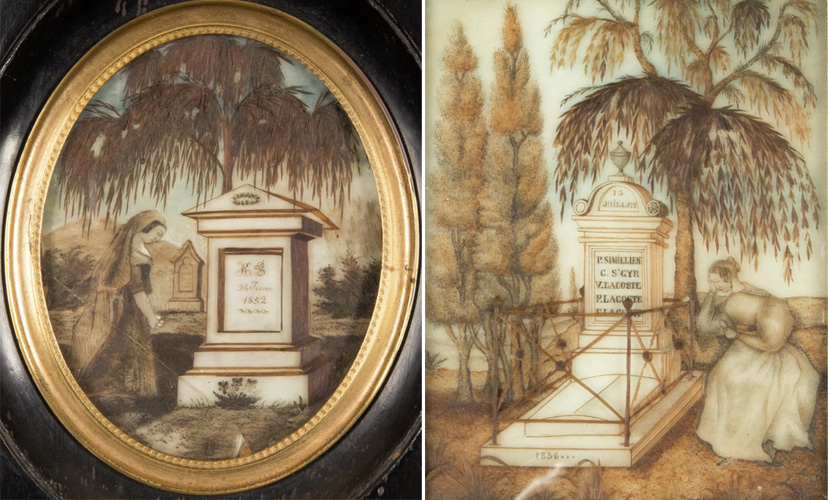Today, people may keep mementos, such as portraits or jewelry, to remind them of a deceased friend or relative, but early Americans took this a step further by holding on to actual pieces of loved ones: their hair. Whether kept as memorials to the departed or as symbols of affection, jewelry and artwork made from human hair were popular from the colonial era until the beginning of the 20th century, when such trends fell out of style.

A group of women places wreaths on tombs on All Saints' Day in New Orleans circa 1900. Hairwork faded from fashion around this time due to the surging popularity of photography. (THNOC, 1985.126.43)
 In the 18th century, hairwork was more understated; mourners might preserve small locks of hair under glass in brooches or rings. As the 19th century Romantic movement encouraged more open and dramatic displays of emotion, hairwork became more elaborate. Women wore entire necklaces or bracelets of woven hair directly against the skin as fashionable jewelry. A portrait of Madame Alcée Villeré (right), shows how stylish women of the 1850s might have worn hairwork. Dark, braided hair bands in her bracelets offer a dramatic contrast to the airy white lace on her dress bodice.
In the 18th century, hairwork was more understated; mourners might preserve small locks of hair under glass in brooches or rings. As the 19th century Romantic movement encouraged more open and dramatic displays of emotion, hairwork became more elaborate. Women wore entire necklaces or bracelets of woven hair directly against the skin as fashionable jewelry. A portrait of Madame Alcée Villeré (right), shows how stylish women of the 1850s might have worn hairwork. Dark, braided hair bands in her bracelets offer a dramatic contrast to the airy white lace on her dress bodice.
Women could order braided hairwork from a jeweler or try their hand at it themselves. Special round worktables with open centers assisted with intricate braiding or weaving. Mark Campbell’s 1867 handbook “Self-Instructor in the Art of Hair Work” offered creative women detailed diagrams and patterns for different braided and beaded hair jewelry designs, as well as for “curls, switches, and braids” to enhance an elaborate updo. Newspaper advertisements show that Campbell marketed his book to New Orleanians. The Decorative Arts of the Gulf South project (formerly the Classical Institute of the South) recently discovered a set of grape-cluster earrings in Wilkinson County, Mississippi, that imitate designs in Campbell’s book.

Sometimes hair was incoroporated in jewlery, such as the grape-cluster earrings shown here, recently documented in a private Mississippi collection. (Image courtesy of the Decorative Arts of the Gulf South project)
Hair could also be used like embroidery thread to make artistic memorial images. After the American Revolution, middle- and upper-class families often sent their daughters to private girls’ schools where schoolmistresses taught basics like reading, writing, and arithmetic, along with artistic subjects like embroidery. Ornamental needlework showcased students’ education and gentility. Training usually emphasized skill over originality, so young ladies often copied mourning scenes with stencils or tracing. George Washington’s death in 1799 ushered in a period of national mourning and proved a particularly popular subject for amatuer artists.

Two pieces of 19th-century hairwork share many similarities, including classical monuments and weeping female figures. (Left: THNOC, gift of Harold Schilke, 1957.124.28. Right: THNOC, The L. Kemper and Leila Moore Williams Founders Collection, 1958.84)
Nineteenth-century mourning scenes used specific motifs like urns, obelisks with inscriptions, and willow trees. Such symbols harked back to classical Greek and Roman monuments, linking the young American republic with ancient traditions. Depictions often included weeping female figures leaning on the obelisks in a Romantic outpouring of grief. These mourning tableaus were usually set in lush landscapes, hinting at the purity of nature and hope for rebirth. Using hair in artwork was another way to engage with and even control the natural world, freezing a moment of a loved one’s life in time.












